NOTE: Since this article was written a number of years ago, Alloy USA has undergone some changes. In my humble opinion, it is not the company it use to be and the quality isn’t there anymore. Ron Stobaugh, who was the driving force behind Alloy USA, has parted ways with them and started a new company, Ten Factory. Ten has hooked up with Motive Gear. Were I in the market for new shafts, I would be contacting them for my needs. I’ve left this write-up on my site simply because it documents what is needed to do this work.
The Dusy-Ershim Trail is a 32 mile long trail that snakes it way through a 600 foot wide corridor between two wilderness areas in the beautiful Sierra Nevada Mountains of California. The plan is to run this 4 day long trail with the same guys I did the Rubicon Trail with several years ago.
So what does this have to do with Alloy USA axle shafts? Well, when I am two days into a trail at 10,000′ in the mountains, the last thing I want to deal with is a broken rear axle shaft. Enter Alloy USA and their D44 high strength alloy axle kit….40% stronger than the stock TJ D44 shafts. I would rather install these in my driveway than worry about replacing the stock shafts on the trail, wouldn’t you? Or put another way….let’s stack the deck in my favor so I can enjoy those 4 days with my friends.

The alloy shafts come complete with everything you need with the exception of the axle retainer plate. Since the retaining plates for drum and disc brake axles are different, you need to stop by the dealership to pick up the correct pair for your brake configuration. Don’t worry too much, the retaining plate might very well be the cheapest part stocked by DC. The Jeep dealership closest to me had them for $3.32 each….I didn’t bother to go calling around in hopes of finding a better price. With gas prices being what they are, I doubt the next closest dealer would be selling them cheap enough for me to save the difference in gas costs. The axle kit contains a left and right side shaft (yes, they are slightly different lengths), two bearings, two bearing retainers, two oil seals, ten wheel studs….and a nice looking sticker.

The axle shaft flange is dual drilled to support both 5 on 5.5″ and 5 on 4.5″ wheels. I’ll be using the inner (5 on 4.5″) set of holes for my setup. If I should ever decide to go with a different front axle that has a 5 on 5.5″ pattern, I won’t have to worry about my rear axles…..just remove the wheel studs from the inner holes and use the outer pattern. That would save a few bucks for sure. Nice touch!

The install was delayed a week as I waited for the axle retainer plates to arrive at the dealership. I stopped by on a Saturday morning to pick up a pair and discovered that the closest ones to me were in California. So the counter guy took my info and promised he would have them by mid-week. Sure enough, in Wednesday’s mail, I had a post card telling me my parts had arrived. The retainer’s part number for my disc brake TJ D44 rear axle, as printed on the packaging, is 1-05083678AA.
Note: If you have drum brakes on your TJ D44 axle, the retaining plate part number is 1-05010811AA.
Note: A friend, ScottF, sent me an e-mail. He has an ’87 XJ D44 axle in his TJ. He didn’t realize the backing plate was different until the TJ plate was installed and the the bearing was pressed onto the shaft. The dealership told him he needed part number 83504190. He opted to weld the holes shut on the wrong plate and re-drill the holes rather than wait for a pair of new plates to arrive. This part number was not confirmed by ScottF.
So install day finally came (that meant it was my day off from work, the lawn had already been mowed on Saturday, etc.). I headed over to Troy’s shop to throw the Jeep up on a lift. Note that it is not necessary, at all, to use a lift for this axle shaft swap. Heck, some folks even do it on the trail. It’s just that right now, it is early August here in Phoenix….that means it is hot…and I do mean HOT in my garage. Troy’s shop has some big fans and evap coolers…..and my garage doesn’t have either. Understand?
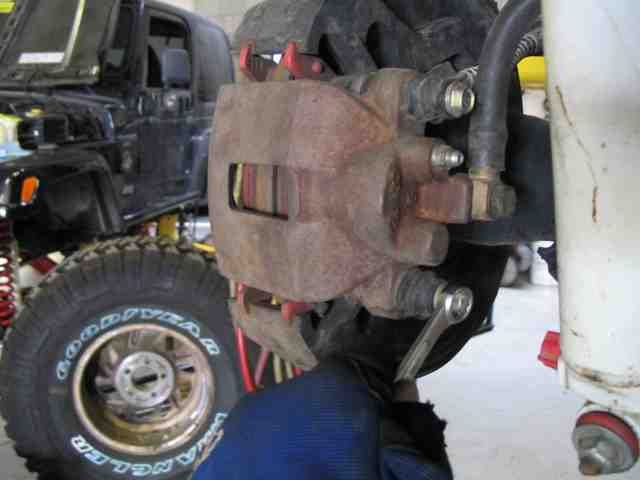
With the TJ on the lift, I removed both rear tires. A 12mm wrench was used to remove the two caliper mounting bolts. With the bolts out of the way, the calipers were removed from the bracket and placed back out of the way by the springs. (don’t hang your calipers from the brake hoses….use a piece of wire if you want to hang them)
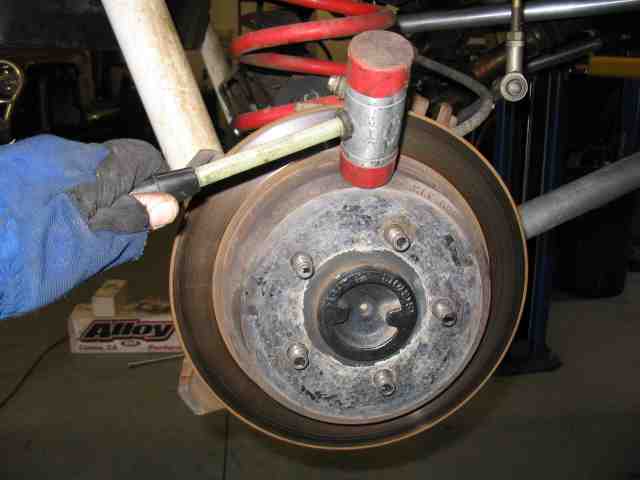
Sometimes the rotors get a little “sticky” and don’t want to slide off. Depending on which part of the country you live in, the rust build up can be rather severe. Here in Arizona, we don’t have too much trouble with it but it can still happen. I couple of whacks was all it took to loosen mine up.
Lady gets Alloy USA D44 Shafts
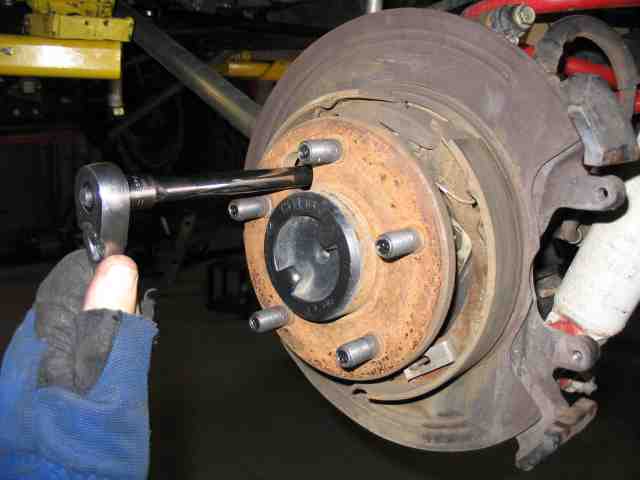
With the rotor removed, it was time to remove the four (4) axle retainer nuts. There is a hole in the flange that allows you to reach the nuts with a socket. Remove a nut, the rotate the flange around until the hole aligns with the next nut, remove it, repeat two more times. I set the nuts aside as they are used to hold the new shafts in place.
When you have removed all four nuts, grab the flange and pull straight towards you. It will come out….it may be a little stubborn, but it will come out. Worst case, you could attach a slide hammer to “pop” it out of the axle tube. But honestly, there should be no reason for it not to come out….I hit mine with the rubber ended hammer I used on the rotors and out it came. Note that you may have some gear lube in the axle tube (this is normal). It may dribble out of the end of the tube when you slide the shaft out and the oil seal unseats itself. I usually have a couple of paper towels handy….one on the floor to catch the drips and another one or two to stuff into the axle tube to stop it from dripping.
The bearing race will probably stay in the end of the axle tube. It needs to be removed. The race is the outer shell of the bearing. Sometimes they can be rather cranky to get out but mine slid out without too much trouble….I just wiggled them a little bit, side to side….slowly working them out of the axle tube. They make a puller that grabs the inside lip of the race and extracts it….in fact, I think it goes on the end of a slide hammer.

With the stock axle shaft now removed from the tube, it was time to assemble the new Alloy USA shaft using the parts supplied and the retainers I got from the dealership. First thing on the list was to clean the lube from the flange and the wheel studs. I assume Alloy USA puts this on to prevent any rusting, etc. Since I was going to use a thread locker compound on the studs, I didn’t want oil in the threads. A can of brake cleaner does a pretty good job for flushing out the oil. I thoroughly sprayed the flange area (specifically the threads) and the wheel studs.
Next on the list was to pack a bit of grease into the bearings. The D44 axle shaft bearings get their lubrication from the diff’s lube oil. However, I prefer to pack the bearings with grease so that the bearings have lube while they wait for the diff lube to get them all nice and slippery.
I also apply a thin film of grease on the inside surface of the oil seal (that part that makes contact with the axle shaft as well on the axle shaft where the oil seal rides. OK….so maybe this is all overkill (at least to some folks no doubt) but then again, I’ve yet to assemble a D44 shaft and have them leak….and that is after multiple years of their going round and round. As long as I keep getting this kind of performance, I’ll keep doing it just like I’ve done it in the past.
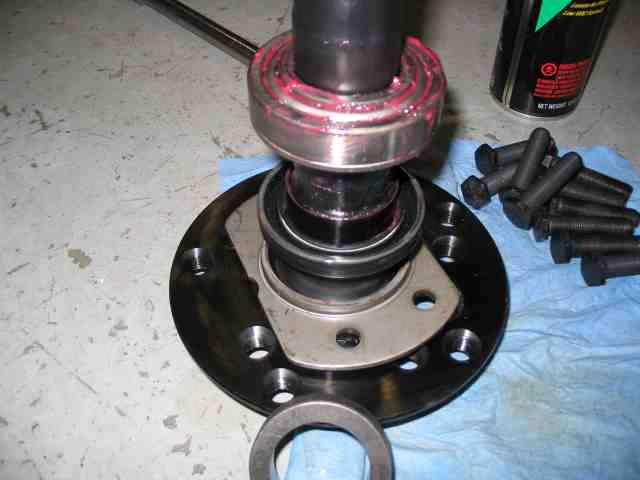
Time to put all the parts together. Slip the axle retainer plate over the shaft. Remember that the lip on the plate goes up (it pushes against the back side of the seal) as shown in the above pic. Then the oil seal is slid into position. The open end faces up, just like in the pic. The bearing is next to go on. Make sure you slide it on the correct way…..you don’t want to mount it backwards. If you don’t know which way it goes on (and maybe even if you do), look at the shaft you just removed and position it in the same manner. The ring you see at the bottom of the above pic is the bearing retainer. That does not go on until the bearing has been seated into its proper position.
OK….time to go over to the hydraulic press.
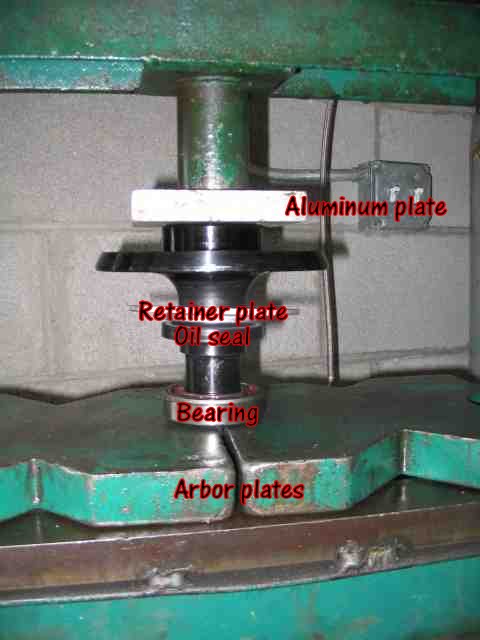
If you don’t have a hydraulic press, you’ll need to find a buddy with one or perhaps a machine shop in your local area. In the pic above, everything is ready for pushing the bearing onto the axle shaft. I used a thick aluminum plate between the ram and the axle shaft. It helps to distribute the pressure over the entire end of the axle shaft rather than concentrating it just in the contact area. The bearing goes on pretty easy. Carefully push the bearing onto the shaft. You will see where it mates up against a machined shoulder on the shaft. Stop when you get to that point.
With the bearing firmly seated, I released the pressure on the press and removed the shaft. The bearing retainer was then slid over the axle shaft and everything was set up again as in the above pic, except this time the bearing retainer was waiting to be pressed into position. The retainer takes a fair amount more pressure in order to properly seat it up against the bearing. Sometimes the pressure builds up a bit and then releases, causing the bearing retainer to “jump” along the shaft, so to speak. Continue applying pressure to the bearing retainer until it comes in contact with the bearing.
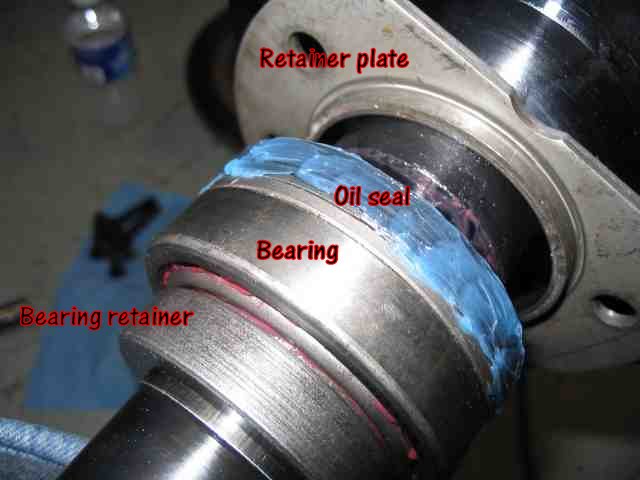
In this pic, you can see the bearing retainer in position adjacent to the bearing. I always put a thin film of RTV sealant on the outer surface of the oil seal. This prevents any leaks that might occur from imperfections at the end of the axle tube.
Lady gets Alloy USA D44 Shafts
With the bearing and its retainer pressed onto the shaft, I grabbed a bottle of thread locking compound (some folks call it Loc-tite) and a socket to fit the wheel studs. I put the thread locker on the last few threads on the studs, covering just enough of them where they will screw into the flange. I gave Alloy USA a call to find out if there were any specs for torquing the wheel studs. Ron answered the phone and said about 65~75 ft. pounds with thread locker applied is all that I needed.
It took only a few minutes to screw the wheel studs into the flange. No more having to press them in with a hydraulic press or a ball joint tool. They went in just fine and I torqued them to 70 ft. pounds.
At this point, I had both Alloy USA shafts fully assembled and ready for installation. The shorter one goes on the driver’s side (unless you live in Australia….but that is a whole different problem that this write-up isn’t addressing).
A couple shots of brake cleaner on a paper towel cleaned up the residual gear lube at the end of the axle shafts. (want to make sure you have a clean surface for the RTV sealant) Of course, as soon as I pulled the paper towel from the axle tube, gear lube dribbled down the freshly cleaned area. I grabbed a screw jack and lifted the end of the axle tube about an inch….no more dribbling gear lube! A few more shots of brake cleaner on a paper towel and a wipe down of the axle tube resulted in a clean area for the oil seal’s RTV.
For replacing the axle shafts, I just reversed the removal steps. The axle shafts were reinserted into the axle tubes and carefully pressed into position. Make sure the oil seal seats properly in the end of the tube. The retainer plate was positioned over the 4 studs (you need to play with this a bit through the hole in the flange) and the 4 nuts previously removed were put back onto the bolts. I snugged them down with a short handled 3/8″ ratchet (not a lot of leverage so they were not torqued down hard) using a criss-cross pattern.
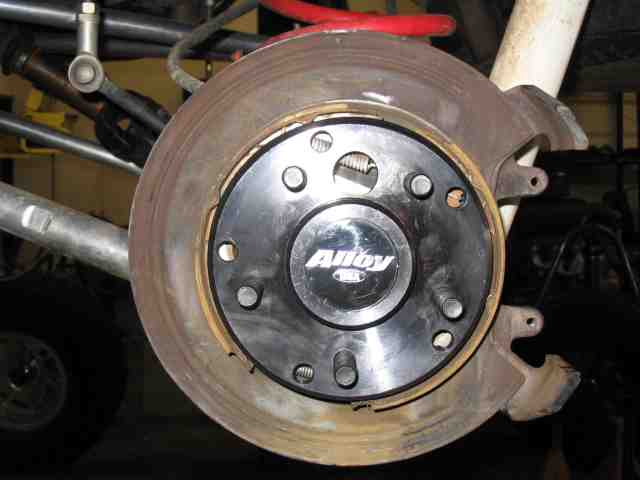
That’s it….with the axle retainer plate nuts tight, all that remains is to slide the rotor over the wheel studs and mount the tire. Don’t forget to torque your wheel studs to 100 ft. lbs. And since these are new studs, you will want to check them again when you have about 50 miles on them.
Well, that wraps up this install and I can cross off one more item from my Dusy-Ershim “to-do” list. I’m ever so much looking forward to the trip….and I now have one less thing on my mind to worry about while I’m climbing over the rocks.
Good trails to you and remember to TREADLightly!
